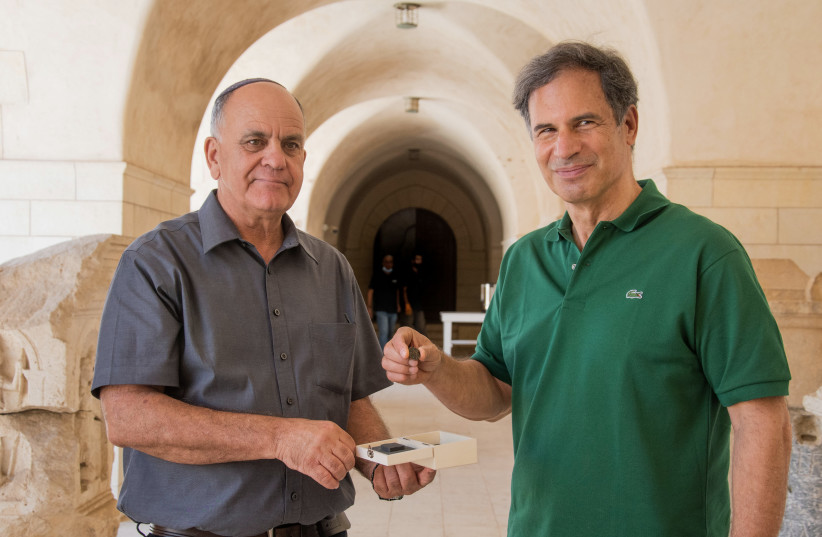An ancient coin dating back to the time of the Bar-Kochba Revolt against the Romans will soon fly into space with Israeli astronaut Eytan Stibbe, the Antiquities Authority (IAA) announced on Thursday.
Eytan Stibbe is set to reach the International Space Station in the “Rakia” Mission led by the Ramon Foundation and the Israel Space Agency as part of the Ax-1 Mission, the first entirely manned by private astronauts.
“As part of the Rakia Mission to the International Space Station, I will be taking with me a bag filled with items that have a special meaning to me,” Stibbe said as he visited the IAA Dead Sea Scrolls laboratory in Jerusalem. “It was clear to me that one of these items will be a symbol of Jewish history. I saw the coin, minted with the palm tree and vine leaves that for me represent the connection to the land, the love of the country, and the desire of the population of Israel in those years for independence. The palm tree particularly touched me, as it is the symbol of the Agricultural Research Organization at Volcani Center, where my father spent his life conducting research on the country’s soil.”

The Bar-Kochba revolt – also known as the Third Jewish Revolt – broke out in 132 CE over religious restrictions imposed by the Romans, as well as their decision to build a Roman city over the ruins of Jewish Jerusalem, including a pagan sanctuary where the Temple destroyed some 60 years earlier had stood. The rebellion was led by Simon Bar Kochba.
At the time, minting coins was an important expression of sovereignty.
“Interestingly, the rebels used existing Roman coins and re-struck them with their own themes and messages,” said Dr. Gabriela Bijovsky, a coin specialist at the IAA. “Such an act was an outrageous affront to the Roman rulers. These coins had first and foremost a symbolic meaning as Jewish propaganda, as they could be used for commerce only among the rebels themselves.”
In addition to various Jewish symbols, the artifacts also carried writings such as “L’herut Yerushalayim” (“Freedom to Jerusalem”).
The coin that Stibbe will carry to outer space reads “Year two of the liberty of Israel.” It was recently found in a historic expedition surveying the caves of the Judean Desert, in order to locate more fragments of the Dead Sea Scrolls and other archaeological remains and save them from looters.
The scrolls are a corpus of 25,000 fragments unearthed in caves on the shores of the Dead Sea in the 1940s and ’50s. They include some of the most ancient manuscripts of the Bible, other religious texts that were not accepted in the canon, and nonreligious writings.
During his visit at the IAA laboratory, Stibbe was shown fragments of the Book of Enoch, written in Aramaic. The book, which is not part of the biblical canon, tells the story of the great-grandfather of Noah and his traveling to heaven.
During his time at the International Space Station, the astronaut will run several experiments on behalf of Israeli universities, start-ups and hospitals.
The goal of the Rakia Mission is to expand the Israeli aerospace industry, but also to inspire a new generation of Israeli children. It will mark the first time they will be able to listen to someone speaking Hebrew from outer space.
“The fact that Eytan chose to take with him to space an ancient item bearing symbolic significance is very exciting and meaningful,” said IAA director Eli Eskosido. “This is a historic meeting between the ancient world and the height of human innovation. The Jewish rebels who struck this coin 1,800 years ago while fighting for their lives and independence could not have imagined in their wildest dreams that after many centuries, this item will make its way to outer space with a Jewish astronaut who lives in an independent Jewish state.”
